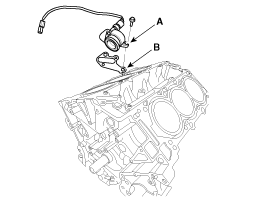Hyundai Genesis: Cylinder Block / Piston and Connecting Rod Repair procedures
Hyundai Genesis (DH) 2013-2016 Service Manual / Engine Mechanical System / Cylinder Block / Piston and Connecting Rod Repair procedures
| Disassembly |
|
|
| 1. |
Remove the engine assembly from the vehicle.
(Refer to Engine And Transaxle Assembly - "Engine And Transaxle Assembly") |
| 2. |
Remove the drive plate and adapter plate.
(Refer to Cylinder Block - "Drive Plate") |
| 3. |
Attach the engine to engine stand for disassembly. |
| 4. |
Remove the exhaust manifold.
(Refer to Intake And Exhaust System - "Exhaust Manifold") |
| 5. |
Remove the intake manifold.
(Refer to Intake And Exhaust System - "Intake Manifold") |
| 6. |
Remove the timing chain.
(Refer to Timing System - "Timing Chain") |
| 7. |
Remove the water temperature control assembly.
(Refer to Cooling System - "Water Temperature Control Assembly") |
| 8. |
Remove the cylinder head.
(Refer to Cylinder Head Assembly - "Cylinder Head") |
| 9. |
Remove the oil pump.
(Refer to Lubrication System - "Oil Pump") |
| 10. |
Remove the oil cover (A) and the gasket (B).
|
| 11. |
Remove the water jacket separator.
(Refer to Cylinder Block - "Water Jacket Separator") |
| 12. |
Remove the knock sensor.
|
| 13. |
Remove the upper oil pan.
(Refer to Lubrication System - "Oil Pan") |
| 14. |
Remove the baffle plate (A).
|
| 15. |
Remove the rear oil seal case (A).
|
| 16. |
Remove the plug bolt (A) and a washer gasket (B).
|
| 17. |
Check the connecting rod cap oil clearance. |
| 18. |
Remove the piston and connecting rod assemblies.
|
| 19. |
Remove the crankshaft bearing cap and check oil clearance. |
| 20. |
Check the crankshaft end play. |
| 21. |
Remove the crankshaft (A).
|
| 22. |
Remove the oil jets (A).
|
| 23. |
Disassemble the piston rings.
|
| 24. |
Remove the snap rings at both ends of the piston pin, and push the piston pin to disconnect the connecting rod. |
| Inspection |
Connecting Rod
| 1. |
Check the connecting rod side clearance.
Using a feeler gauge, measure the end play while moving the connecting rod back and forth.
|
| 2. |
Check the connecting rod bearing oil clearance.
| |||||||||||||||||||||||||||||||||||||||||||||||||||||||||||||||||||||||||||||||
| 3. |
Check the connecting rod.
|
Piston
| 1. |
Clean piston
|
| 2. |
Check the piston-to-cylinder clearance by calculating the
difference between the cylinder bore inner diameter and the piston outer
diameter.
|
| 3. |
Select the piston matching with cylinder bore class.
|
Piston Rings
| 1. |
Inspect the piston ring side clearance.
Using a feeler gauge, measure the clearance between the new piston ring and the wall of the ring groove.
If the clearance is greater than the maximum limit, replace the piston. |
| 2. |
Inspect piston ring end gap.
To measure the piston ring end gap, insert a piston ring into
the cylinder bore. Position the ring at the right angle to the cylinder
wall by gently pressing it down with a piston. Measure the gap with a
feeler gauge. If the gap exceeds the service limit, replace the piston
ring. If the gap is too large, recheck the cylinder bore diameter
against the wear limits. If the bore is over the service limit, the
cylinder block must be replaced.
|
Piston Pins
| 1. |
Measure the external diameter of the piston pin.
|
| 2. |
Measure the piston pin-to-piston clearance.
|
| 3. |
Check the difference between the piston pin diameter and the connecting rod small end diameter.
|
| Reassembly |
|
| 1. |
Assemble the piston and the connecting rod.
|
| 2. |
Install the piston rings.
|
| 3. |
Install the connecting rod bearings.
|
| 4. |
Install the piston and connecting rod assemblies.
|
| 5. |
Install the connecting rod caps and check oil clearance. |
| 6. |
Check the connecting rod end play. |
| 7. |
Install the rear oil seal.
(Refer to Cylinder Block - "Rear Oil Seal") |
| 8. |
Install the baffle plate.
When installing the baffle plate bolts, tighten the bolts in two or three steps according to the sequence shown below.
|
| 9. |
Assemble the other parts in the reverse order of disassembly. |
 Piston and Connecting Rod Components and Components Location
Piston and Connecting Rod Components and Components Location
Components
1. Piston ring2. Piston pin3. Snap ring4. Piston5. Connecting rod6. Connecting rod upper bearing7. Connecting rod lower bearing8. Connecting rod bearing cap
...
 Crankshaft Components and Components Location
Crankshaft Components and Components Location
Components
1. Crank shaft upper bearing2. Thrust bearing3. Crankshaft4. Crankshaft lower bearing5. Main bearing cap
...
Other information:
Hyundai Genesis (DH) 2013-2016 Owners Manual: Seat belt warning light
Seat belt warning light (for driver’s seat) The driver’s seat belt warning light and chime will come on according to the following table when the Engine Start/Stop button is in the ON position. Seat belt warning (for front passenger’s seat) The front passenger's seat belt ...
Hyundai Genesis (DH) 2013-2016 Service Manual: Components and Components Location
Component Location 1. DDM (Driver Door Module)2. ADM (Assist Door Module)3. IGPM (Integrated Gateway Power Control Module)4. Door lock knob5. Trunk lid actuator6. Front soft closing actuator (SCA)7. Front door lock actuator 8. Door lock switch9. RLDM (Rear Left Door Module)10. RRDM (Rear Right ...
© 2013-2025 www.hgenesisdh.com





























